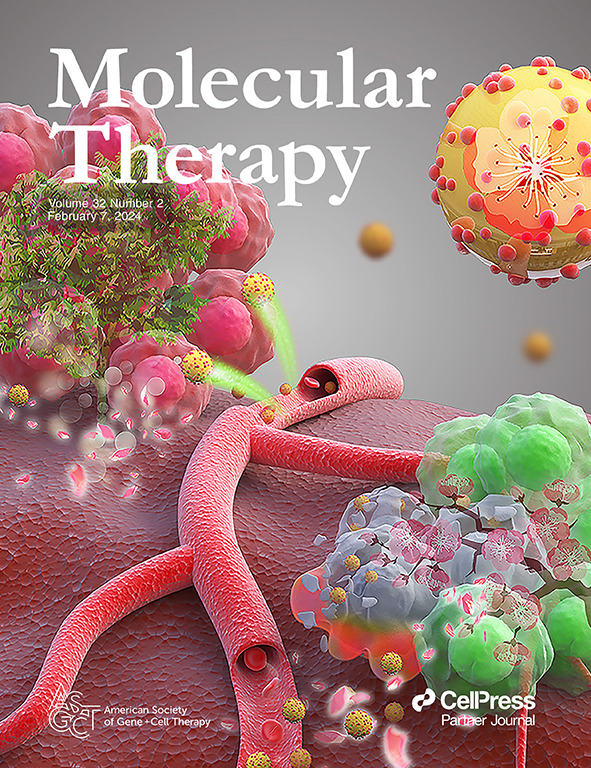AAV-mediated gene therapy for focal epilepsy by expressing neuropeptide Y and Y2 receptor in rodent and non-human primate hippocampus.
IF 12
1区 医学
Q1 BIOTECHNOLOGY & APPLIED MICROBIOLOGY
引用次数: 0
Abstract
Epilepsy affects approximately 50 million people worldwide, and over 30% of patients are considered treatment-resistant to currently available anti-seizure drugs. Neuropeptide Y (NPY) has been shown to inhibit excitatory synaptic transmission in hippocampal slices from human epilepsy patients via Y2 receptors (Y2R), and overexpression of NPY and/or Y2R in the hippocampus reduces seizures in rodent models of epilepsy. In this study, we demonstrate that AAV-mediated delivery of NPY and Y2R using a novel vector (SPK100.NPY-Y2R) inhibits seizures in rodents. SPK100.NPY-Y2R reduced spontaneous neuronal activity in primary rat cortical cultures and attenuated evoked neuronal activity in ex vivo slices of mouse hippocampus. Furthermore, intrahippocampal administration of SPK100.NPY-Y2R reduced the progression and duration of seizures in a rat model of rapid kindling. Parallel experiments confirmed that hippocampal overexpression of NPY and Y2R is also sufficient to reduce spontaneous seizures in a genetic mouse model of epilepsy (synapsin triple knockout). We also demonstrated successful magnetic resonance-guided, convection enhanced delivery of SPK100.NPY-Y2R to the hippocampus of Papio hamadryas (baboon). This approach achieved favorable vector biodistribution and transduction in the hippocampus, with no observed adverse events. These findings support the development of an intrahippocampal AAV.NPY-Y2R therapy for treating seizures in patients with temporal lobe epilepsy.aav介导的基因治疗局灶性癫痫通过表达神经肽Y和Y2受体在啮齿动物和非人灵长类动物海马。
全世界约有5000万人患有癫痫,30%以上的患者被认为对目前可用的抗癫痫药物具有治疗耐药性。神经肽Y (NPY)通过Y2受体(Y2R)抑制人类癫痫患者海马片中的兴奋性突触传递,并且在啮齿动物癫痫模型中,海马中NPY和/或Y2R的过表达减少了癫痫发作。在这项研究中,我们证明了使用一种新的载体(SPK100.NPY-Y2R)介导的aav递送NPY和Y2R可以抑制啮齿动物的癫痫发作。SPK100。NPY-Y2R降低了原代大鼠皮层自发神经元活性,并减弱了小鼠海马离体切片的诱发神经元活性。此外,海马内给药SPK100。NPY-Y2R在快速点火大鼠模型中减少了癫痫发作的进展和持续时间。平行实验证实,海马过度表达NPY和Y2R也足以减少癫痫遗传小鼠模型(突触蛋白三重敲除)的自发发作。我们还成功演示了SPK100的磁共振引导对流增强发射。NPY-Y2R对海马海马的影响。这种方法在海马体中实现了良好的载体生物分布和转导,没有观察到不良事件。这些发现支持海马内AAV的发展。NPY-Y2R治疗颞叶癫痫患者的癫痫发作。
本文章由计算机程序翻译,如有差异,请以英文原文为准。
求助全文
约1分钟内获得全文
求助全文
来源期刊

Molecular Therapy
医学-生物工程与应用微生物
CiteScore
19.20
自引率
3.20%
发文量
357
审稿时长
3 months
期刊介绍:
Molecular Therapy is the leading journal for research in gene transfer, vector development, stem cell manipulation, and therapeutic interventions. It covers a broad spectrum of topics including genetic and acquired disease correction, vaccine development, pre-clinical validation, safety/efficacy studies, and clinical trials. With a focus on advancing genetics, medicine, and biotechnology, Molecular Therapy publishes peer-reviewed research, reviews, and commentaries to showcase the latest advancements in the field. With an impressive impact factor of 12.4 in 2022, it continues to attract top-tier contributions.
 求助内容:
求助内容: 应助结果提醒方式:
应助结果提醒方式:


